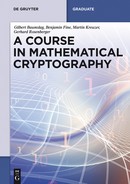Contents
Preface
1.2 Cryptography, Cryptanalysis and Cryptosystems
1.3 A Very Brief History of Cryptography
1.4 Encryption and Number Theory
1.6 Cryptosystems and the Key Space
2.4 Feistel Networks, DES and AES
2.5 One-Way Functions and Trapdoors
3 Cryptanalysis and Complexity
3.1 Cryptanalysis and Cryptanalytic Attacks
3.4 Perfect Security and the One-Time Pad
3.4.1 Vigenere Encryption and Polyalphabetic Ciphers
4.2 Cryptographic Hash Functions
4.5.1 The Shamir Secret Sharing Scheme
4.5.2 Alternatives for Secret Sharing Protocols
4.5.3 Verifying Secret Sharing Protocols (VSS)
5 Elementary Number Theoretic Techniques
5.1 Cryptography and Number Theory
5.3 Units and the Multiplicative Group Z*
5.4 The Field Zp and Finite Fields
5.6 Cyclic Groups and Primitive Elements
5.7 The Chinese Remainder Theorem
6 Some Number Theoretic Algorithms
6.1 Algorithms for Public Key Cryptography
6.2 Quadratic Residues and Square Roots
6.5.1 Shank’s Baby Step Giant Step Algorithm (BSGS)
6.5.3 The Index Calculus Method
6.6.2 Fermat’s Primality Testing
6.6.3 Pseudoprimes and Probabilistic Primality Testing
6.6.4 Miller-Rabin Primality Testing
6.6.5 Mersenne Primes and the Lucas-Lehmer Test
7.2 Standard Model for Public Key Encryption
7.3 The Diffie-Hellman Key Exchange and Protocol
7.4.1 Generalizations of ElGamal
7.5 The RSA Algorithm and Protocol
7.5.3 Practical Implementation of RSA
7.5.4 Feasibility of the RSA Algorithm
7.6.1 Quadratic residues and Rabin Encryption
7.6.3 Security Equivalence of the Rabin Cryptosystem
7.7 Session Keys and Mixed Encryption
8.1 The ElGamal and Elliptic Curve Encryption System
8.2.1 Fields and Field Extensions
8.2.4 The Order of an Elliptic Curve Group
8.2.5 Calculating Points in Elliptic Curve Groups
8.3 Elliptic Curve Cryptography
8.4 Cryptoanalysis of Elliptic Curve Cryptosystems
8.6 The Elliptic Curve Digital Signature
9 Basic Concepts from Group Theory
9.2 Cosets and Normal Subgroups
9.4 Generators and Group Presentations
9.5 Free Groups and Group Presentations
9.7 Presentations of Subgroups
10.2.1 The Wagner-Magyarik Method
10.3.1 An Implementation Within the Classical Modular Group
10.3.2 A Variation Using the Magnus Representation
10.4 Cryptographic Protocols Using Groups
10.5 Non-Abelian Digital Signatures
10.6.1 The Strong Generic Free Group Property
10.6.2 Security Analysis of the Group Randomizer Protocols
10.6.3 Actual Implementation of a Group Randomizer System Protocol
11.1 Cryptographic Platforms and Platform Groups
11.2 The Ko-Lee and AAG Protocols
11.2.2 The Anshel-Anshel-Goldfeld Protocol
11.3 Some Other Group Based Cryptosystems
11.5 Hard Group Theoretic Properties
11.7.3 The Pure Braid Group for Bn
11.7.4 Linear Representations of Bn
11.8 Cryptanalysis of Braid Group Cryptosystems
11.8.1 Attacks on the Conjugacy Search Problem
11.8.3 Representation Theoretic Attacks
11.8.4 Braid Group Security Summary
11.9 Some Other Braid Group Based Protocols
12.1 Finitely Presented Groups and Cryptography
12.2 Group Theory for Access Control
12.3 Public Key Control Groups
12.4 Diophantine Control Security groups
12.5 The Social Security Control Groups
12.6 Further Extensions of Diffie-Hellman and RSA
13 Commutative Grobner Basis Methods
13.1 Commutative Grobner Bases
13.2 Commutative Grobner Basis Cryptosystems
13.3 Algebraic Attacks Using Grobner Bases
13.3.1 The Grobner Basis Attack
13.3.2 The Integer Programming Attack
14 Non-Commutative Grobner Basis Methods
14.1 Non-Commutative Grobner Bases
14.2 Elimination and its Applications
14.4 Non-Commutative GB Cryptosystems
15.1 Lattice-Based Cryptography
15.3 Lattices and Their Properties
15.3.1 The Geometry of Numbers
15.5 Lattice Reduction and Babai’s Algorithm
15.6 Main Lattice Based Cryptosystems
15.6.1 Ajtai’s Hash Function and Cryptosystem
